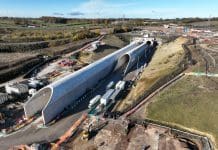Housing delivery will fail to meet the needs of the places it hopes to support without integrated infrastructure, says the Institution of Civil Engineers (ICE)
A reform of the way infrastructure and housing are delivered, ensuring a more strategic and aligned approach, is necessary if the government is to deliver on its housebuilding programme, says ICE.
As part of its annual State of the Nation report series, ICE has this year focused on the relationship between housing and economic infrastructure.
The report, State of the Nation 2019: Connecting Infrastructure with Housing, was launched on 10 September at ICE’s London headquarters.
ICE vice president Rachel Skinner, chair of the report’s steering group, said: “We know that the provision of housing in the UK, as a key part of creating high-quality, productive places, is one of the country’s most pressing problems.
“However, we must also recognise that without properly integrated infrastructure, it can often fail to meet the needs of the places it hopes to support.
“There is now clear evidence that shows the majority of the population would support new housing projects if they included the necessary infrastructure, such as transport, energy and water.
“ICE’s State of the Nation 2019 report comprehensively assesses the ways in which we can better deliver infrastructure and housing in a coordinated and integrated way, which will have long-term benefits for communities throughout the country.”
Report recommendations
The report makes recommendations which it believes will help bring these two important sectors closer together.
The 10 recommendations cover the areas of planning, funding and financing, and futureproofing.
ICE suggests the creation of regional infrastructure strategies across England to better ensure effective integrated infrastructure and housing planning across boundaries and at local, regional and national levels.
It also suggests that the government should amend the Development Consent Order process to enable larger-scale housing developments to be built.
The report recommends that the next National Infrastructure Assessment should identify options for futureproofing new and existing housing stock to ensure suitability for the future.
In particular, it advises of the potential to consider how housing and infrastructure can be delivered to reach the net zero carbon targets, while taking full advantage of appropriate technological advancements.
Public perceptions of infrastructure and housing
As part of the report’s research, ICE had Ipsos MORI conduct a public survey to gauge the UK’s views on the importance of the infrastructure and housing relationship.
The survey found that a majority of the population (60%) say they would support the building of more housing in their local area if any necessary new infrastructure was built at the same time.
The same survey found that 32% of British adults believe decisions about what new housing is needed should be taken both nationally and locally. While 38% believe decisions about what new infrastructure is needed should be taken nationally and locally.
Sir John Armitt CBE FICE, chair of the National Infrastructure Commission, said: “New housing is essential if the UK is to meet the demands of a growing population, but it needs effective infrastructure to transform houses and flats into thriving communities where people want to live and work.
“We also need homes and places designed for our future, not our past. That means housing set up for the switch to low-carbon power and heating and designed with electric car charging in mind and fast digital connectivity as a necessity not a luxury, situated in well-designed communities – connected by effective transport networks – that can support jobs, growth and a good quality of life.
“Too often, however, infrastructure and housing delivery aren’t properly aligned. The ICE’s call for more integrated housing and infrastructure planning is a welcome contribution to this increasingly important discussion.”
Victoria Hills MRTPI FICE, chief executive of the Royal Town Planning Institute, commented: “The Royal Town Planning Institute is delighted to support the findings of the ICE report. RTPI has long campaigned for the planning profession to be empowered to take its role in bringing together infrastructure and housing development, through cross-boundary spatial strategies, to create economically sustainable places.
“Our recent research on the Location of Development found that over half of the houses permitted are not within easy walking or cycling distance of a railway, metro or underground station. We welcome the ICE’s report and further evidence that infrastructure should not be considered in isolation of other development, and also the recognition of the crucial role planners play.
“This is why we call on government and local authorities to better resource planning and put planning at the heart of local delivery for local people.”
Caroline Gumble, chief executive of the Chartered Institute of Building (CIOB), added: “The CIOB fully supports the recommendations by the Institution of Civil Engineers (ICE) to align the way in which infrastructure and housing are delivered with a more strategic approach.
“The idea of the development of integrated regional infrastructure strategies, which include the planning and construction of new housing, could prove to be an important tool in ensuring that government meets its commitment to increase the number of homes available across the country.
“The CIOB also hopes to support the development of these strategies with research and data into the value of construction across the regions of the UK, which will be available later this year.
“A new approach is also another opportunity to embed a new culture across the industry, from housebuilding to large, regional infrastructure projects. We’d very much like to see quality placed at the heart of the strategy, following the principles outlined in our Code of Quality Management. The development of fully integrated regional infrastructure strategies is an ideal showcase for quality in the built environment and the drive to raise standards.”










![[VIDEO] Cambridge waste water plant granted permission to relocate Artist impression of the new Cambridge waste water plant and surrounding land](https://www.pbctoday.co.uk/news/wp-content/uploads/2025/04/p.151-768x364-1-218x150.jpg)



